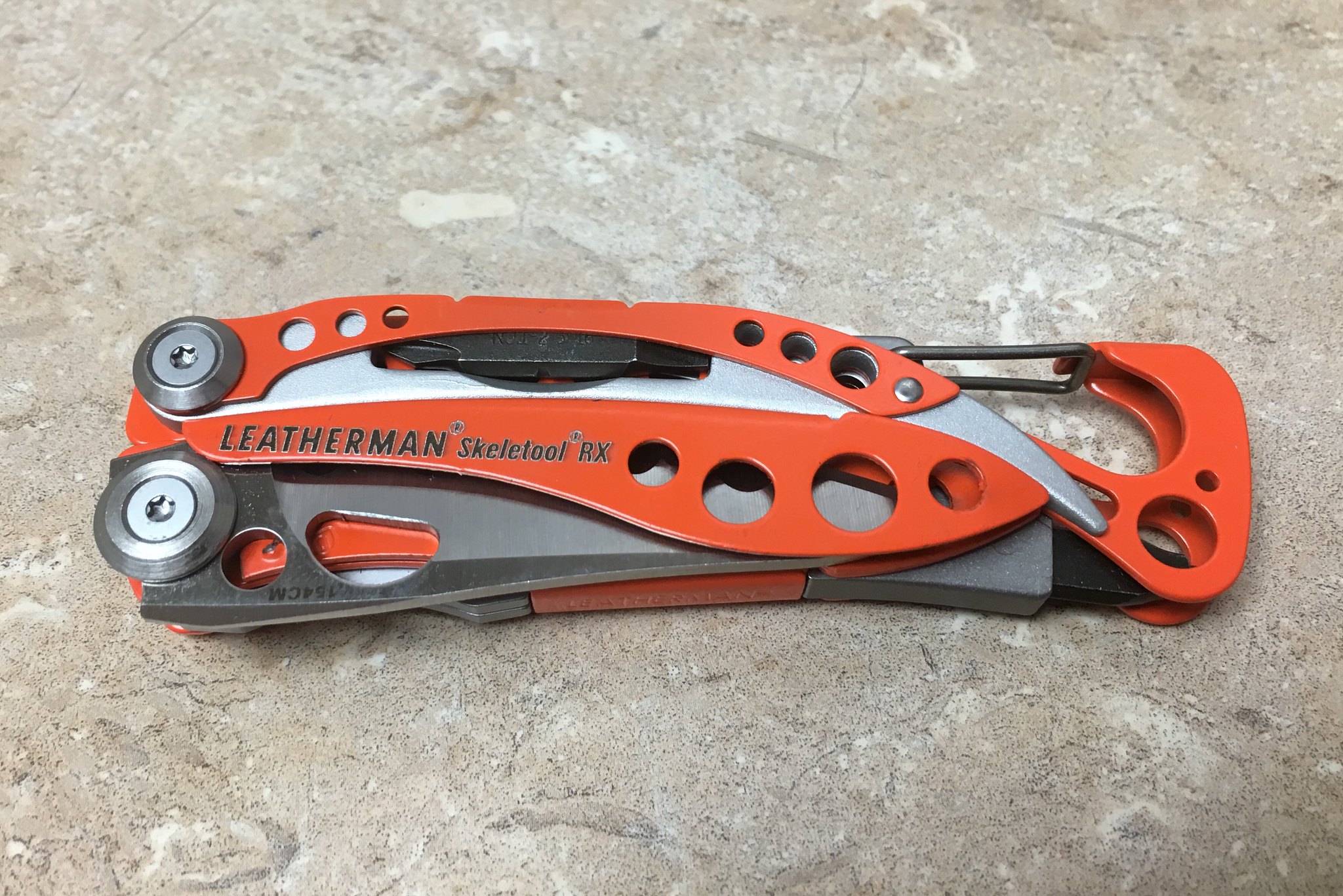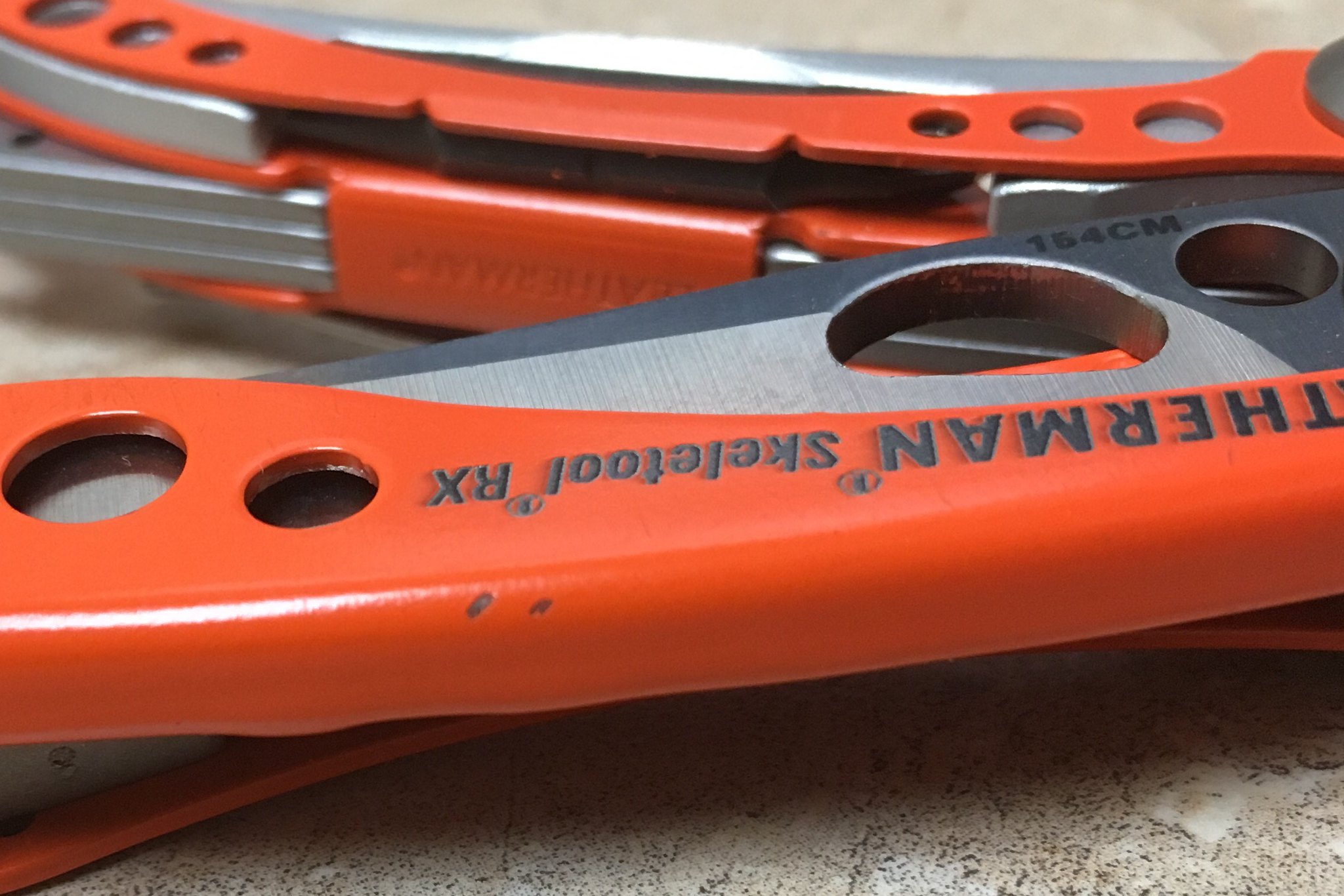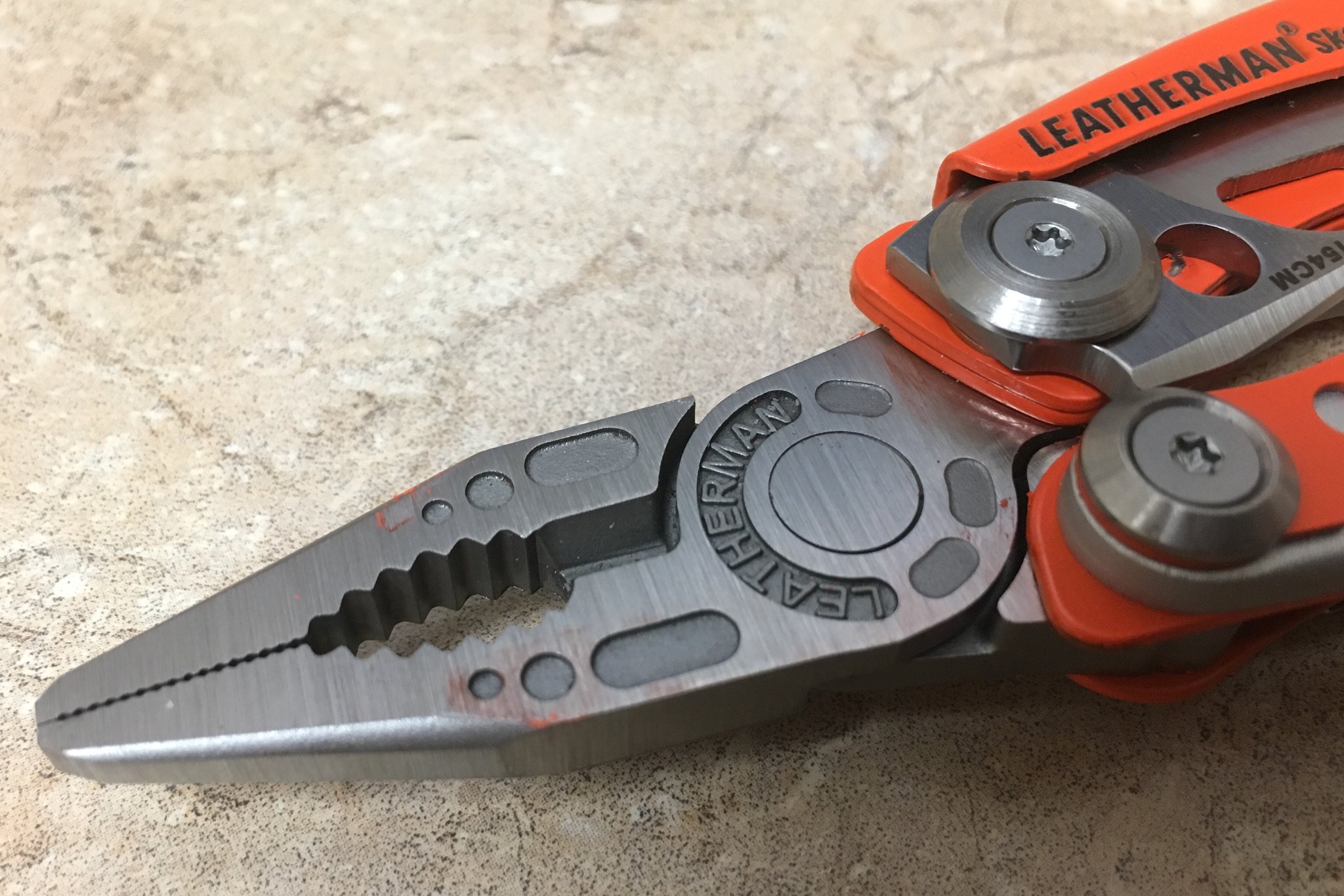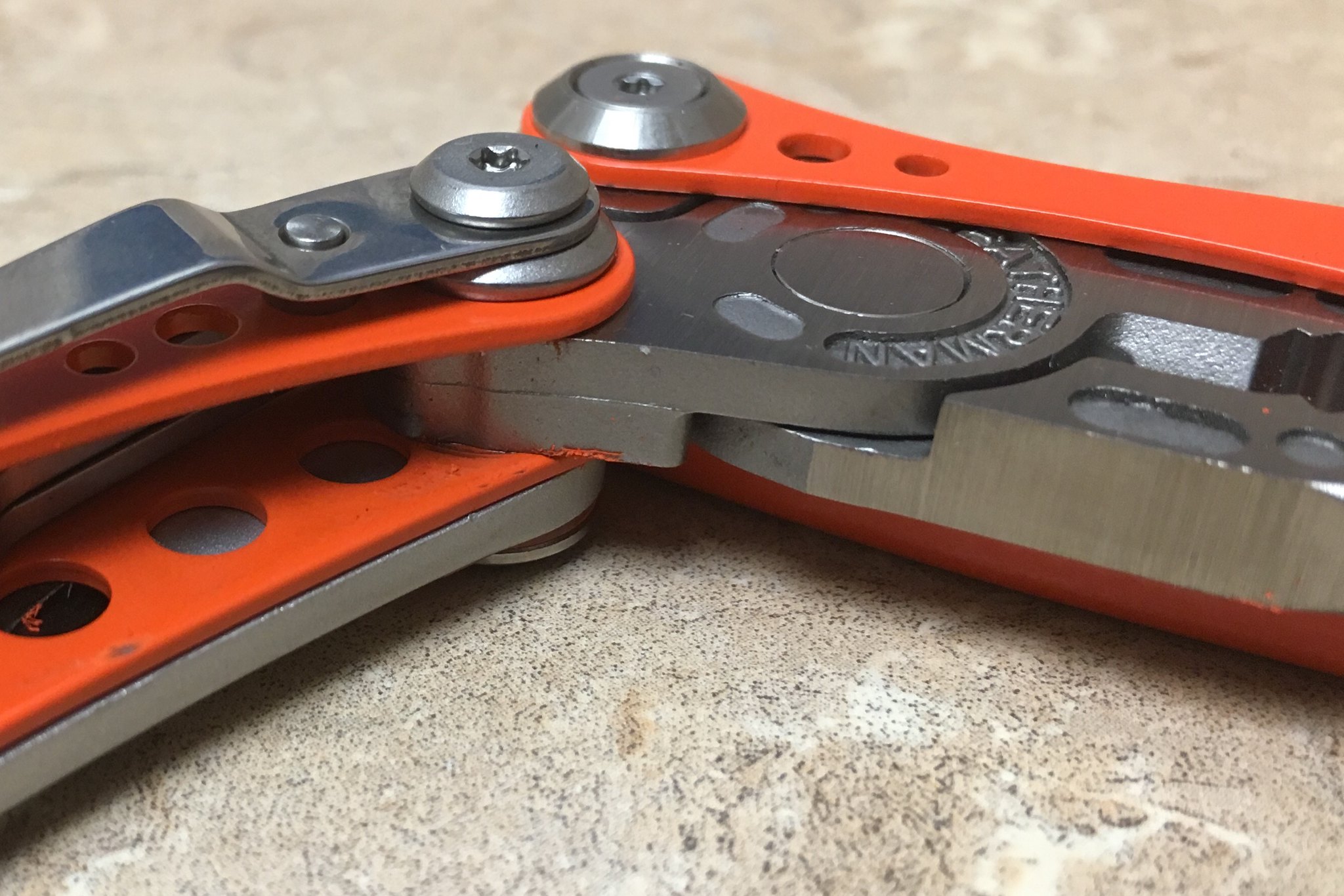I had asked Leatherman when this tool would become available, and they told me July 1. But a member of another forum informed me that REI currently had it available exclusively, so I went to their website and found that my local REI did indeed habit it in stock. I went there to buy one last week. It was $89.99.
Since this tool is almost completely the same as a regular Skeletool, I'm not going to discuss the basic tool itself. Instead, I'm going to address the few differences. As far as I can tell, there are only three major differences: the orange Cerakote finish, the knife blade, and the carbide glass breaker bit.
The glass breaker tip is on a bit that has a 1/4" flat screwdriver tip on the other end. The other bit that's stored in the handle has a 3/16" tip at one end, and a Philips tip on the other end that's labeled "No. 1-2". In contrast, my regular Skeletool has two bits, one with the same two flathead tips, and the other with two Philips bits, each one separately labeled No. 1 and No. 2. To my eyes, the Philips tip on the bit with the RX looks to be the same size as the smaller Philips tip, the No. 1, from the regular Skeletool. So with the RX, you lose the larger Philips screwdriver bit to get the glass breaker tip.
The carbide glass breaker tip will be familiar to first responders. It's meant to break tempered glass, such as a vehicle's side windows, by concentrating the force of your swing into a point. I have personally never had to do that, nor have I tested this particular glass breaker. But this is the kind of thing that really can't not work. The only real negative about this glass breaker, though, is the fact that you have to open up the tool to actually gain access to it.
On my Skeletool RX, the bit pulls out of the socket quite easily. The retainer clip, that you're supposed to push in on to release the bit, doesn't really seem to do much at all on this particular tool. On my older regular Skeletool, I can also pull the bit out without releasing the retainer, but it takes considerable more effort than on my new RX.
Next, let's take a look at the knife blade. On the RX, the blade is made from 154CM steel, which is a fairly common steel for knives that aren't junk. Emerson Knives uses this steel in almost all their knives, for example. The Skeletool CX also uses 154CM, but the regular Skeletool uses 420HC.
The blade on the RX is serrated for almost the entire length. Only about the last half-inch is a plain sharpened edge. The scallops of the serrations are larger (go higher up into the blade) than the serrations on the regular Skeletool's blade. The tip of the blade is more of a sheepsfoot design than on the other Skeletools. I believe the intention of this design was to make it less likely to stab into a victim you're rescuing, but because of the way the tip of the knife curves up, the point is still forward and it would be quite easy to accidentally stab someone with this if you were working with this blade close to their body.
Now let's discuss the orange Cerakote finish. Cerakote is a ceramic/polymer coating that is supposed to improve resistance to wear, corrosion, chemicals, and abrasion. Because it is a coating, it adds thickness to what it's coating, and this fact does not seem to have been taken into account by Leatherman. My Skeletool RX is new, has never been used, and has only been handled myself, opening and closing it a few times to check it out. Yet I can see in numerous places where the coating is being worn off or scratched through from the tool itself. This is most prominent around the main pivot, both where the two frame halves rub against each other while rotating open, as well as where the pliers rub against the frame. Mine also had a few nicks in the finish that don't appear to be caused by anything, and are probably just flaws in the finish that maybe should've been caught and rejected by quality control.
All the features that Cerakote is supposed to provide could probably be accomplished adequately enough with plain stainless steel. I would guess that the real reason for this finish is to add the orange color.
Finally, let's address the overall usefulness of this tool as a rescue tool. To put it bluntly, I feel it is of very little usefulness as a rescue tool. There are two main things this tool can do in a rescue situation: break glass, and cut through stuff. As a glass breaker, it probably works just fine, though as I said, I didn't actually test that function. The only downside here is that you have to open the tool and get a good grip on it to use it as such. As far as cutting through stuff, it would be fine cutting through anything that isn't close to a victim's body. It would be far to easy to accidentally cut a person you're working close to with this blade.
I have never known any rescuer to need pliers during a rescue, and if they need wire cutters, they need something much more big and robust than the tiny wire cutters inside the pliers of the Skeletool.
You could say that this tool, as a compromise between a more fully-featured multitool and a dedicated rescue tool, is a good thing to carry perhaps when you're off duty and not carrying anything else. But there are many other tools that are also "good to have when you don't have anything else." Perhaps my opinion is biased because I've been a first responder for many years and my carry load-out has already been refined to a point that I'm quite familiar and comfortable with, and this tool doesn't add anything new, nor does it combine two or more tools I already have into the simplicity of one. But what it comes down to is that this tool has no place with me, and I cannot see any compelling reason to recommend it to anyone else.
Now for some photos.
Folded

Opened up

Two nicks in the finish that in my opinion, should've been QC failures

On the pliers you can see orange discoloration from where they've been rubbing against the Cerakote finish

The folded pliers, with bits of scraped-off orange Cerakote just where they go into the frame

On the pliers near the frame pivot, you can see more orange Cerakote that's been scraped off; on the frame near the left edge of the photo, you can see another spot of the coating that's been worn thin by the corresponding bottom edge of the pliers near the right side of the phot, where some more specks of coating are present

Here you can see several places where the coating has been worn thin or scraped off, either from rubbing against itself or rubbing against uncoated tool metal

Since this tool is almost completely the same as a regular Skeletool, I'm not going to discuss the basic tool itself. Instead, I'm going to address the few differences. As far as I can tell, there are only three major differences: the orange Cerakote finish, the knife blade, and the carbide glass breaker bit.
The glass breaker tip is on a bit that has a 1/4" flat screwdriver tip on the other end. The other bit that's stored in the handle has a 3/16" tip at one end, and a Philips tip on the other end that's labeled "No. 1-2". In contrast, my regular Skeletool has two bits, one with the same two flathead tips, and the other with two Philips bits, each one separately labeled No. 1 and No. 2. To my eyes, the Philips tip on the bit with the RX looks to be the same size as the smaller Philips tip, the No. 1, from the regular Skeletool. So with the RX, you lose the larger Philips screwdriver bit to get the glass breaker tip.
The carbide glass breaker tip will be familiar to first responders. It's meant to break tempered glass, such as a vehicle's side windows, by concentrating the force of your swing into a point. I have personally never had to do that, nor have I tested this particular glass breaker. But this is the kind of thing that really can't not work. The only real negative about this glass breaker, though, is the fact that you have to open up the tool to actually gain access to it.
On my Skeletool RX, the bit pulls out of the socket quite easily. The retainer clip, that you're supposed to push in on to release the bit, doesn't really seem to do much at all on this particular tool. On my older regular Skeletool, I can also pull the bit out without releasing the retainer, but it takes considerable more effort than on my new RX.
Next, let's take a look at the knife blade. On the RX, the blade is made from 154CM steel, which is a fairly common steel for knives that aren't junk. Emerson Knives uses this steel in almost all their knives, for example. The Skeletool CX also uses 154CM, but the regular Skeletool uses 420HC.
The blade on the RX is serrated for almost the entire length. Only about the last half-inch is a plain sharpened edge. The scallops of the serrations are larger (go higher up into the blade) than the serrations on the regular Skeletool's blade. The tip of the blade is more of a sheepsfoot design than on the other Skeletools. I believe the intention of this design was to make it less likely to stab into a victim you're rescuing, but because of the way the tip of the knife curves up, the point is still forward and it would be quite easy to accidentally stab someone with this if you were working with this blade close to their body.
Now let's discuss the orange Cerakote finish. Cerakote is a ceramic/polymer coating that is supposed to improve resistance to wear, corrosion, chemicals, and abrasion. Because it is a coating, it adds thickness to what it's coating, and this fact does not seem to have been taken into account by Leatherman. My Skeletool RX is new, has never been used, and has only been handled myself, opening and closing it a few times to check it out. Yet I can see in numerous places where the coating is being worn off or scratched through from the tool itself. This is most prominent around the main pivot, both where the two frame halves rub against each other while rotating open, as well as where the pliers rub against the frame. Mine also had a few nicks in the finish that don't appear to be caused by anything, and are probably just flaws in the finish that maybe should've been caught and rejected by quality control.
All the features that Cerakote is supposed to provide could probably be accomplished adequately enough with plain stainless steel. I would guess that the real reason for this finish is to add the orange color.
Finally, let's address the overall usefulness of this tool as a rescue tool. To put it bluntly, I feel it is of very little usefulness as a rescue tool. There are two main things this tool can do in a rescue situation: break glass, and cut through stuff. As a glass breaker, it probably works just fine, though as I said, I didn't actually test that function. The only downside here is that you have to open the tool and get a good grip on it to use it as such. As far as cutting through stuff, it would be fine cutting through anything that isn't close to a victim's body. It would be far to easy to accidentally cut a person you're working close to with this blade.
I have never known any rescuer to need pliers during a rescue, and if they need wire cutters, they need something much more big and robust than the tiny wire cutters inside the pliers of the Skeletool.
You could say that this tool, as a compromise between a more fully-featured multitool and a dedicated rescue tool, is a good thing to carry perhaps when you're off duty and not carrying anything else. But there are many other tools that are also "good to have when you don't have anything else." Perhaps my opinion is biased because I've been a first responder for many years and my carry load-out has already been refined to a point that I'm quite familiar and comfortable with, and this tool doesn't add anything new, nor does it combine two or more tools I already have into the simplicity of one. But what it comes down to is that this tool has no place with me, and I cannot see any compelling reason to recommend it to anyone else.
Now for some photos.
Folded

Opened up

Two nicks in the finish that in my opinion, should've been QC failures

On the pliers you can see orange discoloration from where they've been rubbing against the Cerakote finish

The folded pliers, with bits of scraped-off orange Cerakote just where they go into the frame

On the pliers near the frame pivot, you can see more orange Cerakote that's been scraped off; on the frame near the left edge of the photo, you can see another spot of the coating that's been worn thin by the corresponding bottom edge of the pliers near the right side of the phot, where some more specks of coating are present

Here you can see several places where the coating has been worn thin or scraped off, either from rubbing against itself or rubbing against uncoated tool metal

